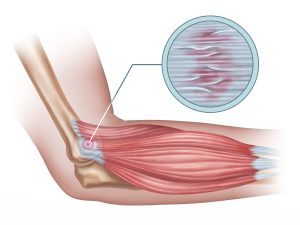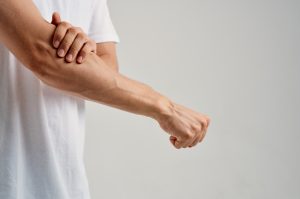
By Andrew Barton, BPhty Allsports Physiotherapist / Director and Sarah Hambleton, BPhty Allsports Physiotherapist
Have you ever experienced elbow pain or known someone who has?
Chances are that you have! Tennis elbow (or lateral epicondylalgia) is the most common form of lateral (outside) elbow pain, with 40% of people experiencing it at one point in their life.[1] Tennis elbow usually occurs in 35 to 54-year-olds.[1]
The good news is that tennis elbow is very treatable with physiotherapy. Individualized exercises and some simple changes to your activities can be effective at combating this frustrating injury. [1]
As physios, our patients often tell us about their elbow pain and then say, “But I don’t play tennis so it can’t be tennis elbow.” Contrary to the name, tennis elbow isn’t always caused by tennis!
Tennis elbow occurs due to repetitive use of one of the tendons on the outside of the elbow. These tendons connect the muscles in the forearm to the bone on the outside of the elbow and produce movement at the wrist. Overload on these tendons can be from work involving repetitive arm or wrist movements such as carpentry, butchery or bricklaying, tennis or other racquet sports, or even keyboard use. The symptoms may start after you’ve spent a weekend doing work in the garden, getting a new tennis racquet, or starting a new job. In some cases, there is no clear reason for the onset of tennis elbow pain.
Symptoms of tennis elbow are pain on the outside of the elbow that can radiate into the forearm, and which is aggravated by wrist movements or gripping. Some people also experience pain in their neck, and sometimes one of the nerves in the arm can become sensitive and contribute to the pain. Tendon injuries are slow to get better, usually taking between 3-6 months, but sometimes longer depending on the person and how they manage their symptoms. Slower recovery is often thought to be due to the fact that tendons don’t have a good blood supply, which is essential for healing.

Common signs of tennis elbow include:
- Pain over the outside of the elbow when lifting
- Pain over the outside of the elbow after sleeping on your side
- Pain over the outside of the elbow to touch
- Trouble brushing your hair or teeth
- Pain with shaking hands
- Pain when picking up your morning coffee
If you’ve ever had tennis elbow, you can truly understand how annoying this injury is to deal with given we use our hands all day. Thankfully, physiotherapy has proven to be an effective treatment for tennis elbow [1].
Common physiotherapy tennis elbow treatments often prescribed in clinic include:
- Exercise therapy (directed to the elbow and upper limb)
- Manual therapy to the elbow, as well as the neck and upper back as indicated
- Prescription of braces and taping
- Soft tissue massage
- Dry needling
- Postural correction techniques
Exercise is the most important part of a rehabilitation program for tennis elbow, as tendons don’t get better with rest. Tendons need to be put under the right amount of load to gradually increase their strength – too much load, and you won’t get better, not enough load and you won’t get better either. Management programs often start with eccentric exercises, which have been shown to relieve pain in people with tennis elbow [1] but everyone responds differently which is why it’s important to be assessed by a physiotherapist. Once your pain has settled, exercises should be designed to gradually strengthen the tendon and increase its tolerance for load. Your physiotherapist will be able to individually prescribe exercises based on your symptoms, and progress them as needed.
Some cases of tennis elbow tend to be milder and simple, small modifications can help.
Here are some helpful tips that you can try at home to help manage and recover from your tennis elbow injury:
- Make sure you set your computer up correctly so that your eyebrows are in line with the top of your monitor
- Try and pick up objects with your palm facing up to the sky
- Try to pick up objects with 2 hands
- Self-massage to the forearm muscles
- Ice over the outside part of the elbow
- Tennis elbow braces
We’re here to help
As with any pain or injury, getting an accurate diagnosis is really important. Your neck, upper back, shoulders and some nerves can cause pain in the same area which can be mistaken for tennis elbow pain. If you are unsure, or would like some advice, call into one of your local Allsports clinics to chat with a physiotherapist to help solve your tennis elbow problem and determine the best treatment for you.
References
[1] Bisset, LM., Vincenzino, B. Physiotherapy management of lateral epicondylalgia. Journal of Physiotherapy 61: 174–181. 2015.


